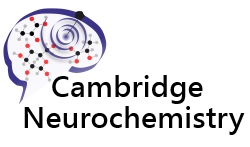13C-labelled microdialysis overview
 We have pioneered the technique of 13C-labelled microdialysis, which enables us to interrogate a number of different metabolic pathways in the human brain. We are the only group worldwide with this expertise. As diffusion across the microdialysis membrane is bi-directional, microdialysis can be used to deliver molecules to the brain ("retrodialysis"), thereby micro-dosing a region of interest around the catheter tip whilst simultaneously collecting the downstream products in the emerging microdialysate.
We have pioneered the technique of 13C-labelled microdialysis, which enables us to interrogate a number of different metabolic pathways in the human brain. We are the only group worldwide with this expertise. As diffusion across the microdialysis membrane is bi-directional, microdialysis can be used to deliver molecules to the brain ("retrodialysis"), thereby micro-dosing a region of interest around the catheter tip whilst simultaneously collecting the downstream products in the emerging microdialysate.
This method has significantly improved our understanding of brain chemistry following injury. This work was performed with MRC funding, using high-resolution 13C nuclear magnetic resonance (NMR) spectroscopy in the Department of Chemistry.
 13C-labelled microdialysis has also led to the identification of potential therapeutic strategies such as glucose and succinate supplementation; both of which we are currently investigating in a clinical setting. To complement these studies the use of imaging techniques including magnetic resonance imaging (MRI) and in vivo spectroscopy - currently 31P MRS and, in future, 13C MRS also – can address brain energy status following injury, and whether this can be improved by clinical intervention. This work is being performed in collaboration with Marius Mada and Adrian Carpenter in the Wolfson Brain Imaging Centre (WBIC), using a custom 31P head-coil (designed to facilitate use with neurocritical care patients) funded by the MRC.
13C-labelled microdialysis has also led to the identification of potential therapeutic strategies such as glucose and succinate supplementation; both of which we are currently investigating in a clinical setting. To complement these studies the use of imaging techniques including magnetic resonance imaging (MRI) and in vivo spectroscopy - currently 31P MRS and, in future, 13C MRS also – can address brain energy status following injury, and whether this can be improved by clinical intervention. This work is being performed in collaboration with Marius Mada and Adrian Carpenter in the Wolfson Brain Imaging Centre (WBIC), using a custom 31P head-coil (designed to facilitate use with neurocritical care patients) funded by the MRC.
13C-labelled microdialysis studies by our group include, most recently, administered disodium 2,3-13C2 succinate (12 mmol/L) by retrodialysis into the monitored region of the brain.


